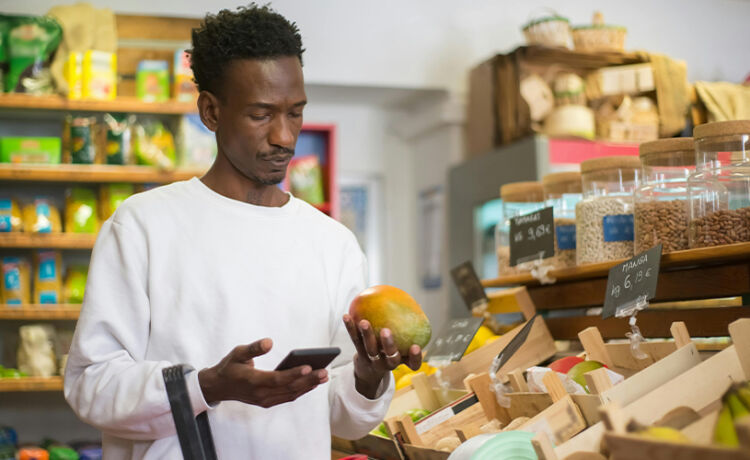
The shift from print to digital marketing is no longer just an option for grocery retailers. It’s a necessity.
In many ways, the rise of grocery retailers adopting digital marketing represents an evolution of the established relationship between grocery chains and digital marketing.
As shopper behaviors change and adapt and digital platforms dominate consumer attention, grocery retailers must rethink their digital marketing strategies to stay competitive.
For many, this begins with reallocating budgets to embrace the opportunities of digital marketing.
The online grocery customer base counts roughly 150 million shoppers, a significant portion of the country’s population, and is forecast to grow further in the upcoming years.
Keep reading to learn strategies to make your digital marketing budget more effective.
The Shift From Print to Digital
Traditionally, grocery retailers have allocated as much as 70–80% of their marketing budgets to print circulars. The majority of consumers still prefer to shop in brick-and-mortar stores. But the popularity of shopping in person doesn’t mean that a digital presence is unimportant.
While print still holds value in some markets, it’s no longer the primary channel for reaching today’s digital-savvy shoppers. Whether through websites, social media, or mobile apps, digital platforms offer unparalleled opportunities for targeted engagement, tracking, and ROI. In fact, by 2028, retail media is projected to account for nearly a quarter of all US media ad spending.
Transitioning your marketing budget isn’t about eliminating print overnight. Instead, it’s about finding the right balance for your business and audience. Some retailers have already gone 100% digital, while others are experimenting with a 50/50 split. The key is to take it one step at a time and base your decisions on solid data and clear goals.
Steps to Transition Your Budget
Transitioning your marketing budget from traditional print to digital channels doesn’t happen overnight. It requires a thoughtful approach to ensure you’re investing in strategies that deliver measurable results.
1. Analyze Your Current Spend
Start by performing a market analysis to evaluate the ROI of your print campaigns. Are your print ads driving store traffic or product sales? Compare this to your digital engagement metrics to identify areas where a shift in focus could yield better results.
2. Update Existing Digital Assets
Your website is the cornerstone of your digital presence. Ensure it’s responsive, user-friendly, and fully integrated with essential features like digital circulars, coupons, and recipes.
3. Decide Who You Need to Reach
Understanding your target audience is critical to spending an marketing budget strategically. Different products appeal to different demographics, so tailor your campaigns accordingly. Identifying your ideal shopper profiles will help you allocate resources efficiently, minimize wasted spend, and guide optimizing ads.
4. Set Financial Goals and Budget
While digital marketing can be cost-effective, it’s essential to understand your budget to prioritize campaign output. Assessing your budgetary constraints and recognizing your financial limits allows you to concentrate on strategic and tactical aspects of your digital marketing.
By following these steps, grocery retailers can confidently reallocate their digital marketing budgets toward digital strategies that offer greater flexibility, reach, measurement and engagement. The key is not to rush but to transition gradually, guided by data and shopper behavior insights.
Prioritize Shopper Engagement Tools
For decades, the weekly ad has been the centerpiece of grocery marketing, driving shopper engagement and sales. However, as consumer preferences shift and the reign of print advertising comes to an end, grocery retailers face the challenge of modernizing this essential tool.
Digital circulars are more than just online versions of print ads. They’re interactive experiences that showcase weekly deals and promotions in a shopper-friendly format. Digital circulars stand out by offering an interactive, engaging experience that integrates seamlessly with other digital features. Shoppers can explore weekly deals, clip digital coupons, and even discover meal ideas through a recipe database.
Despite the rise of digital marketing, the weekly ad remains the most visited feature on grocery websites. Shoppers turn to it for deals, inspiration, and planning their purchases. If you want to transform your weekly ad into a powerful digital engagement tool, elevate your circular to meet the demands of a digital-first world.
How to Build Value Through Digital Offers
While the grocery category has historically lagged behind other retail sectors in adopting advanced media technologies, it also offers some of the most valuable insights into household demographics and purchasing behaviors. Digital offers, such as coupons, loyalty rewards, and personalized promotions, are both effective and efficient.
Retail media has also emerged as a transformative opportunity for grocery retailers, representing an $8.5 billion market in the U.S. for 2024. Not only that, but 97% of grocers plan to use these solutions, prioritizing speed and expertise over the time and expense of building in-house capabilities.
The competition is fierce so to stand out, grocery retailers must adapt strategically. Digital offers aren’t just about discounts; they’re about creating value for both your shoppers and your business. By integrating them across your digital channels, personalizing promotions, and leveraging loyalty programs, you can deliver a seamless, engaging experience that builds long-term customer relationships
Webstop Makes Digital Marketing Work for You
At Webstop, we understand that successful digital marketing goes beyond driving traffic. Digital campaigns can be combined with the valuable features Webstop is known for already:
- Digital Circulars: Our digital circulars aren’t just a digital version of print—they’re an exclusive, interactive experience tailored to shopper preferences.
- Digital Coupons: Savings drive shopper engagement, and our integrated digital coupon solutions deliver just that.
- Basket-Building Recipes: With a database of over 5,000 recipes combined with integrating recipes into the shopper journey, we turn simple ad clicks into meaningful connections that boost both engagement and sales.
Our integrated approach to digital marketing ensures your campaigns are not only effective but also deeply aligned with your shoppers’ needs.
Ready to create impactful digital campaigns that deliver results and delight shoppers? Contact Webstop today to learn how we can optimize your digital marketing strategy and help you stay ahead in a competitive market.
